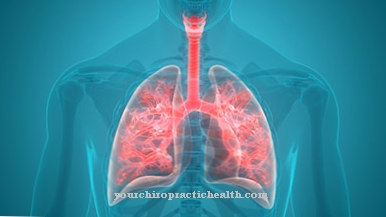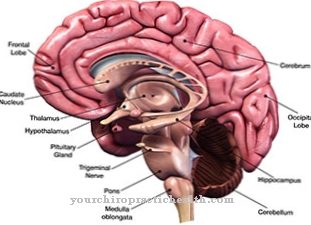Of the Seasickness experienced seafarers may still be affected. In addition to patience, various measures can help alleviate or prevent symptoms of seasickness.
What is seasickness?

© tarapatta - stock.adobe.com
The so-called Seasickness is actually not a disease in the narrower sense, but rather a healthy body reaction to an unusual movement that the body experiences, for example when traveling on a ship.
Conceptually, seasickness is a form of travel sickness. People react differently to movements that can lead to seasickness: While a large part of the population shows an 'average' susceptibility to developing seasickness, there are minorities who develop seasickness very quickly or very rarely.
Infants and people over the age of 50 tend to have seasickness very rarely. Science assumes that not only humans but also various animals can develop symptoms of seasickness.
causes
Among the causes of a Seasickness For example, what counts is the fact that the brain receives contradicting information from the body: If, for example, the waves cannot be observed with the eyes during a boat trip, the brain cannot interpret the movement reports from the equilibrium organ.
Another contributing factor to seasickness is the fact that no activity signal from the muscles reaches the brain despite registered movements. The contradicting messages are ultimately interpreted as a dangerous situation and the symptoms of seasickness arise due to the release of stress hormones.
Symptoms of seasickness can not only be caused by real situations, but also by appropriately designed cinema presentations or computer games. One reason that infants usually do not develop seasickness is that the balance organ is not yet fully developed.
Symptoms, ailments and signs
Seasickness includes many different symptoms, which can vary in individual cases. Typical signs include dizziness and nausea, which can lead to vomiting. As a result, electrolyte imbalances and dehydration are possible. In most cases, however, these complaints from seasickness are not life-threatening.
Sometimes the sight or smell of food makes the nausea worse. Heartburn or a lack of appetite may also occur. People who suffer from seasickness sometimes have intestinal problems. Digestive activity often drops, which can lead to constipation.
People may feel exhausted and tired from seasickness. The drowsiness can extend to lethargy. Pallor and headache are also common symptoms of seasickness. Serious circulatory problems, however, rarely occur. Often people who suffer from seasickness sweat. You may also shiver or shiver. The various complaints sometimes lead to motor insecurity, temporary gait disorders or balance disorders.
Mental symptoms are common in seasickness. They include depression, emotional numbness, difficulty concentrating, and problems with motivation. A depressive mood or general displeasure are also possible. Some people also have the impression that they perceive their surroundings as if they were dampened by cotton wool or fog.
Diagnosis & course
It is often the case that the symptoms of Seasickness lose weight if you are exposed to unfamiliar movements for a few days. Now the probability of showing symptoms of seasickness again during further exposure also decreases.
Seafarers may suddenly develop symptoms of seasickness after years without seasickness. Other seafarers show symptoms again every time they sail. A diagnosis of seasickness is based on the typical symptoms of nausea, vomiting or dizziness that occur while a person concerned finds himself in a movement situation that corresponds to a situation on a ship with swell.
Complications
Seasickness results from the fact that the eyes and the organ of equilibrium in the inner ear absorb opposing sensory perceptions that the brain has to process. The brain reacts to this form of stress with messenger substances such as histamine and serotonin. The histamine stimulates the vomiting center in the brain, which ultimately triggers the symptoms of seasickness. Usually, the side effects subside on their own after a few days without complications.
In some cases, however, the typical symptoms such as nausea, dizziness, nausea and diarrhea persist throughout the entire voyage. People who show severe and long-lasting symptoms may have to end a sea voyage prematurely. Extremely strong nausea and severe diarrhea that lasts for days can also lead to significant weight loss and circulatory problems.
Those affected then feel weakened for days even after the symptoms have subsided. For patients who suffer from cardiovascular disease or are already physically weak for other reasons, excessive loss of fluids from constant vomiting or diarrhea can even be life-threatening. It is imperative that these victims receive medical attention.
Seasickness can also trigger an acute attack in patients with migraines. It must be expected that the migraine attack will then be significantly more severe than under normal conditions.
When should you go to the doctor?
If you are seasick, you don't always need to see a doctor. A visit to the doctor is usually only necessary if the person concerned is suffering from very severe and severe symptoms. Most of those affected snore very loudly and heavily, so that their partner's quality of life is also negatively affected. A doctor should be consulted if the patient snores loudly and suffers from disorders of the heart or from disorders of concentration. Disturbances of the erection or, in general, a lack of sexual desire can clearly indicate the disease and should also be examined and treated by a doctor.
A doctor should also be consulted if the patient suffers from severe heartburn or dizziness. In the case of seasickness, the family doctor can be visited. Further treatment, however, depends heavily on the exact type and severity of the symptoms, so that this is usually carried out by another specialist.
Treatment & Therapy
There are different approaches to one Seasickness to treat.First of all, there are some behavioral measures available that can reduce seasickness: For example, it is initially recommended to go above deck on a boat trip and not stay inside. To combat the symptoms of seasickness, ideally one should adapt to the movements of the ship on deck. It is useful to fix a certain point on the horizon.
Using relaxation techniques can also help with seasickness. If the symptoms of seasickness are already very severe, it can be helpful to lie down flat in a part of the ship where comparatively little ship movements can be felt.
Studies have shown that placebos (products that contain no active ingredients, but the user accepts it) are very effective in treating seasickness. This mechanism of action is probably due, among other things, to the fact that the person concerned is relieved of the fear of continuing to suffer from seasickness. This decrease in anxiety then has a positive effect on symptoms of seasickness.
Finally, there are medicines for severe seasickness (both prescription and over-the-counter medicines). If an affected person is already vomiting, a suppository shape can be the most suitable. Possible side effects of such drugs are tiredness or a decrease in the ability to react.
prevention
Also about one Seasickness To prevent this, there are possible behavioral measures and (in the case of known susceptibility) also medication (for example in the form of depot patches). At the behavioral level, it is advisable, for example, to eat mostly easily digestible food on the eve of a boat trip. Coffee, alcohol and nicotine should also only be consumed to a limited extent shortly before and during a cruise.
Aftercare
Since real seasickness is incurable in most cases, no real aftercare can take place. When the patient is back on land, the symptoms usually subside within a short time. At the very beginning, if there are still a few problems, only light food should be enjoyed or, even better, only herbal tea should be drunk.
This is the fastest way to guarantee recovery. Especially when the stomach empties on board due to the rocking movements of the ship, the seasick has to drink a lot in order to supply the body with important lost salts and sufficient fluids.
If possible, boat trips should be avoided in the future. As a rule, however, river cruises are much quieter, which is why seasickness cannot even arise here. Short trips can be used to find out how tolerable such a river cruise is.
If a trip on the open sea is planned again, waters or seasons should be chosen in which there can be no strong turbulence. In any case, it is very helpful to get suitable medication to prevent seasickness from the pharmacy before you start your journey.
You can do that yourself
Seasickness is often easily accessible to self-help in everyday life. There are some means with which one can prevent the appearance or at least significantly alleviate its severity. These are briefly presented below.
Seasickness is closely linked to our equilibrium and our senses. The view of a billowing sea can trigger them. Therefore, godmothers with the appropriate disposition can move into an inside cabin on a large ship that can eliminate this cause. When the sea is stormy, this can then be preferred.
An empty stomach is often a disadvantage in terms of seasickness. Patients with this condition are best to make sure they always have something in their stomach that is easy to digest. You should also ensure that you drink enough water, especially when vomiting cannot be avoided. Alcohol and nicotine can make seasickness worse and should be reduced significantly or not consumed at all.
There are a number of naturopathic practices that can be effective for seasickness. It is often worth trying acupuncture. Globules or other homeopathic remedies for seasickness can be taken on the ship itself. These are also good for children. Relaxation methods or yoga can also be very efficient helpers in case of seasickness.





.jpg)





















